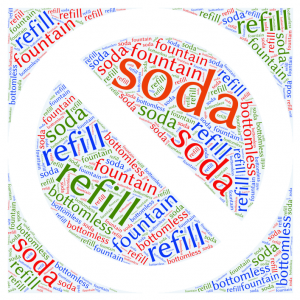Late last week, the French government boosted its efforts to tackle obesity by banning free soda refills. The soda refill ban builds on a series on measures the French government ha s implemented to reduce consumption of unhealthy foods and beverages: there is a nation-wide tax on sweetened drinks, vending machines are banned in schools, and french fries may only be served once a week in school cafeterias. Inspired by the French government’s ongoing efforts to adopt a range of measures to reduce soda consumption, this post suggests additional measures US lawmakers can take to build on the momentum of soda taxes.
s implemented to reduce consumption of unhealthy foods and beverages: there is a nation-wide tax on sweetened drinks, vending machines are banned in schools, and french fries may only be served once a week in school cafeterias. Inspired by the French government’s ongoing efforts to adopt a range of measures to reduce soda consumption, this post suggests additional measures US lawmakers can take to build on the momentum of soda taxes.
The French ban on free soda refills
The French soda refill ban covers drinks with added sugars or sweeteners and applies to all public eateries, including school cafeterias and fast food restaurants.
While France has among the lowest rates of overweight and obesity in OECD countries, rates are increasing and there are large social disparities. The soda refill ban, in combination with other efforts to promote healthier food and beverage consumption, is intended to reduce obesity and diabetes, especially among young people in France.
Additional measures to reduce soda consumption
In the United States, soda taxes are gaining serious momentum as an effective and popular means of reducing obesity, diabetes, and other health conditions associated with consumption. Eight U.S. jurisdictions have public health-based soda taxes: Albany, Berkeley, Oakland, and San Francisco in California; Boulder, Colorado; Cook County, Illinois; Philadelphia, Pennsylvania; and the Navajo Nation.
While taxes show great promise to help reduce soda consumption, soda taxes, alone, are not enough. In some jurisdictions, soda taxes are not politically feasible. Evidence gathered in the tobacco control field confirms that “the most successful tobacco control strategies appear to involve multiple policies implemented as part of a comprehensive strategy.” Complementary measures help shape and reinforce societal norms and different policies can target different demographic groups, with the potential to reduce disparities. Learning from tobacco control efforts, governments seeking to reduce consumption of unhealthy foods and beverages should aim for multiple measures, including taxes, bans and restrictions targeting educational institutions, and measure to increase accessibility and affordability of healthier options.
State and local governments have a range of policy options available to complement or work towards soda taxes. Under California law, for example, schools must provide access to free, fresh drinking water during meal times and 66% of beverages and 35% of food in vending machines on state property must meet nutritional requirements. Stockton and Davis, California, require either milk or water to be served as the default drink in children’s meals. A City Council member in Baltimore is advocating for businesses to post signs warning of the health impacts of sugary beverages.
The increasing use of soda taxes in the to reduce consumption is a step forward in the fight against obesity and diabetes. Complementary measures, from soda bans in schools to warning labels can contribute to reduced consumption and build momentum for future governmental efforts to enable healthier food and beverage consumption.



